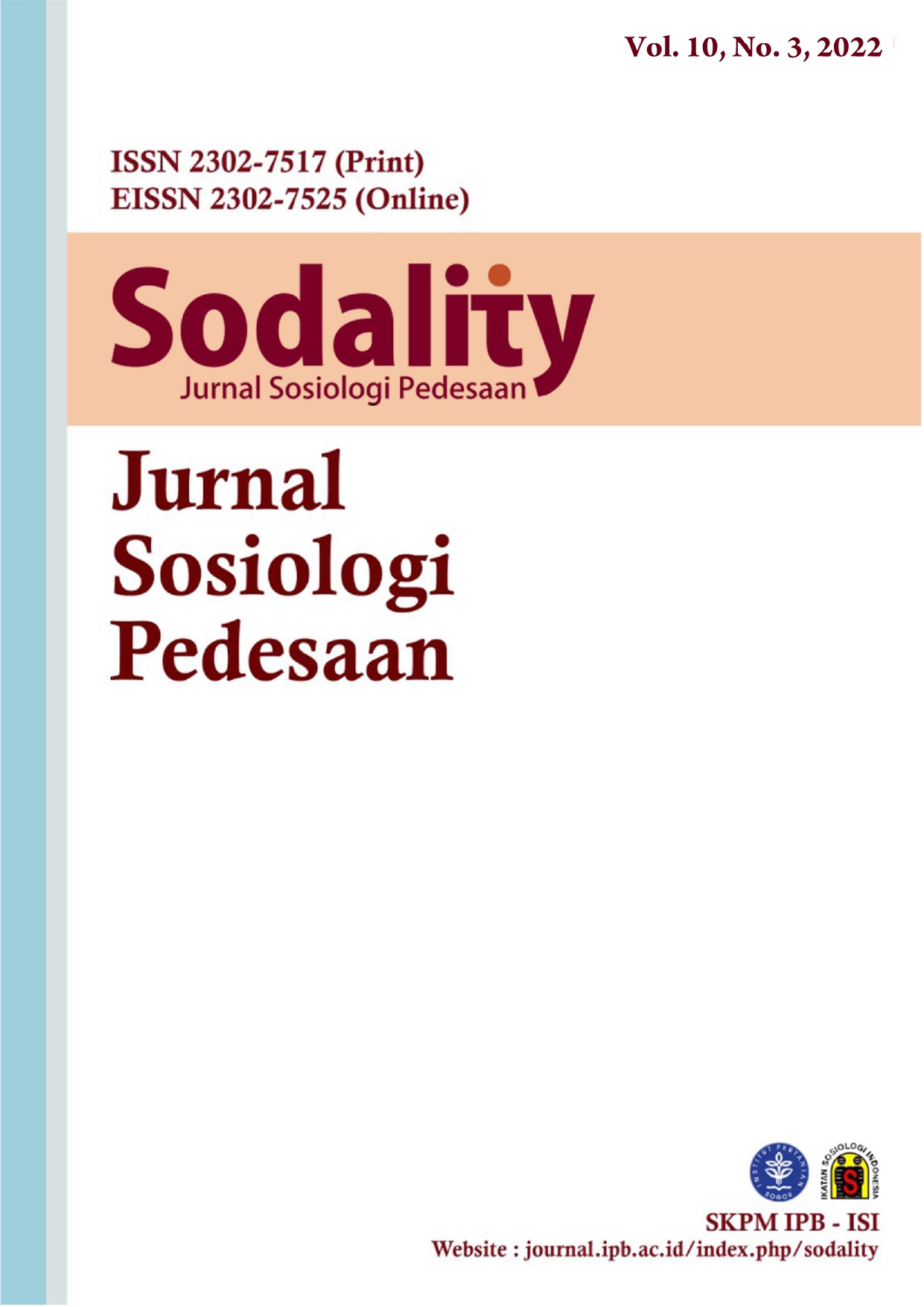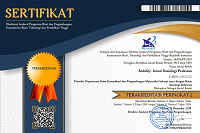Typology of Tourism Village Settlement in Indonesia
Abstract
As a fast-growing industry sector, tourism has become an essential economic basis for villages. Law No 6 of 2014 has broadened the opportunity for villages to develop. A tourism village is considered one of the community empowerment options that can improve the economy and the village's development. Moreover, with all their uniqueness, tourism villages are also regarded as capable of eliminating urbanization's negative impact. Of 83.820 villages in Indonesia, 2% of them are tourism villages. This study took a sample of 55 tourism villages selected by the purposive sampling method and then described the sample based on five typologies, namely the settlement configuration, the classification of the village, the accessibility, the tourist attraction, and the category of the tourism village. The data used in the study were collected from various sources, specifically, those taken from official documents, credible websites, and previous studies to describe the typology owned by villages to become fast-growing tourism villages. The results show that, generally, tourist villages in Indonesia are dominated by rural tourism villages; however, urban tourism villages have a faster development. This study also points out the determining aspect of tourist village development.
References
Aji, R. R., Pramono, R. W. D., & Rahmi, D. H. (2018). Kontribusi Sektor Pariwisata Terhadap Ekonomi Wilayah Di Provinsi Jawa Timur. Jurnal Planoearth, 3(2), 57. https://doi.org/10.31764/jpe.v3i2.600
Alwi, I. (2015). Kriteria Empirik dalam Menentukan Ukuran Sampel Pada Pengujian Hipotesis Statistika dan Analisis Butir. Formatif: Jurnal Ilmiah Pendidikan MIPA, 2(2), 140–148. https://doi.org/10.30998/formatif.v2i2.95
Ardhana, I. K., Maunati, Y., Budiana, D. K., Zaenuddin, D., Gegel, I. P., Kawiana, I. P. G., Muka, I. W., & Wibawa, I. P. S. (2020). Pemetaan Tipologi Dan Karakteristik Desa Adat Di Bali. Cakra Media Utama.
Ardilafiza, Warman, K., Illahi, B. K., & Tegnan, H. (2021). Ancient Sites, History and Local Wisdom: Tourism Boosting Reforms to Improve the Economy and Living Standard in the Province of Bengkulu, Indonesia. Ancient Asia, 12, 1–11. https://doi.org/10.5334/aa.235
Bogdanov, N., Meredith, D., & Efstratoglou, S. (2008). A typology of rural areas in Serbia. Economic Annals, 53(177), 7–29. https://doi.org/10.2298/EKA0877007B
Bowen, E. G. (1926). A Study Of Rural Settlements in South-West Wales. The Geographical Teacher SPRING, 13(4), 317–324.
Checkland, P. (1981). System Thinking, System Practice. John Wiley & Sons.
Ching, F. D. K. (1979). Architecture, Form, Space and Order (Vol. 148). Van Nostrand Reinhold.
Dorrell, D., Henderson, J., Lindley, T., & Connor, G. (2018). Introduction to Human Geography. University System of Georgia.
Faisal, G., & Ikaputra. (2022). Tipologi Permukiman di Indonesia: Penjejangan, Dikotomi, Konteks Sosial, dan Spasial. Langkau Betang: Jurnal Arsitektur, 9(2), 141–155. https://doi.org/10.26418/lantang.v9i2.51813
Friedmann, J. (1981). Toward a The Active Community : for Framework Political-Territorial Rural Development in Asia *. University of Chicago Press, 29(2), 235–261.
Friedmann, J. (1996). Modular cities: beyond the rural-urban divide. Environment and Urbanization, 8(1), 129–131. https://doi.org/10.1630/095624796322752975
Goe, W. R., & Noonan, S. (2007). The Sociology of Community. In 21st Century Sociology (pp. I-455-I–464). SAGE Publications, Inc. https://doi.org/10.4135/9781412939645.n46
Hall, D., Kirkpatrick, I., & Mitchell, M. (2005). Rural tourism as sustainable business: Key themes and issues. In Rural Tourism as Sustainable Business.
Kementerian Pariwisata dan Ekonomi Kreatif. (2022). JADESTA: Jejaring Desa Wisata. https://jadesta.kemenparekraf.go.id/
Kumurur, V. A., & Damayanti, S. (2009). Pola Perumahan dan Pemukiman Desa Tenganan Bali. Jurnal Sabua, 1(1), 1–7.
Labolo, M. (2017). Peluang dan Ancaman Otonomi Desa Pasca Undang-Undang Nomor 6 Tahun 2014 tentang Desa. Jurnal Ilmiah Wahana Bhakti Praja, 7(2), 73. https://doi.org/10.33701/jiwbp.v7i2.42
Lane, B. (1994). What is rural tourism? Journal of Sustainable Tourism, 2(1–2), 7–21. https://doi.org/10.1080/09669589409510680
Lee-Hsueh, L. (2018). Ecological Aesthetics: Design Thinking to Landscape Beauty with Healthy Ecology Lee. Intech, 32, 137–144.
Lew, A. A. (1987). A framework of tourist attraction research. Annals of Tourism Research, 14(4), 553–575. https://doi.org/10.1016/0160-7383(87)90071-5
Lewis, C. A., & Mrara, A. Z. (1986). Rural Settlements, Mission Settlements and Rehabilitation in Transkei. GeoJournal, 365–374.
Li, Y., Wu, W., & Liu, Y. (2018). Land consolidation for rural sustainability in China: Practical reflections and policy implications. Land Use Policy, 74(June 2017), 137–141. https://doi.org/10.1016/j.landusepol.2017.07.003
Lieskovský, J., Bezák, P., Špulerová, J., Lieskovský, T., Koleda, P., Dobrovodská, M., Bürgi, M., & Gimmi, U. (2015). The abandonment of traditional agriculture landscape in Slovakia - Analysis of extent and driving forces. Journal of Rural Studies, 37, 75–84. https://doi.org/10.1016/j.jrurstud.2014.12.007
Medlik, S. (2003). Dictionary of Travel, Tourism & Hospitality. In Director (third). Butterworth-Heinemann.
Moneo, R. (1978). Opposition. Ideas and Criticism in Architecture, 112–127. https://doi.org/10.4324/9781315135038-10
Nurvianti, & Hastuti. (2021). Community Participation in the Development of Taman Sari Tourism Village, Yogyakarta, Indonesia. Journal of Sustainability Science and Management, 16(5), 263–287. https://doi.org/10.46754/JSSM.2021.07.017
Petrović, M. D., Lukić, D. M., Radovanović, M., Vujko, A., Gajić, T., & Vuković, D. (2017). Urban geosites as an alternative geotourism destination - Evidence from Belgrade. Open Geosciences, 9(1), 442–456. https://doi.org/10.1515/geo-2017-0034
Pickel-Chevalier, S., Bendesa, I. K. G., & Darma Putra, I. N. (2021). The integrated touristic villages: an Indonesian model of sustainable tourism? Tourism Geographies, 23(3), 623–647. https://doi.org/10.1080/14616688.2019.1600006
Prishchepov, A. A., Müller, D., Dubinin, M., Baumann, M., & Radeloff, V. C. (2013). Determinants of agriculture land abandonment in post-Soviet European Russia. Land Use Policy, 30(1), 873–884. https://doi.org/10.1016/j.landusepol.2012.06.011
Reif, B. (1973). Models in Urban and Regional Planning. Leonard Hill Books.
Suwaryo, U. (2011). Mengembalikan Otonomi Untuk Desa. Governane, 2(1), 1–11.
Tóth, G., & Dávid, L. (2010). Tourism and accessibility: An integrated approach. Applied Geography, 30(4), 666–677. https://doi.org/10.1016/j.apgeog.2010.01.008
Trisnawati, A. E., Haryono, H., & Wardoyo, C. (2018). Pengembangan Desa Wisata dan Pemberdayaan Masyarakat Berbasis Potensi Lokal. Jurnal Pendidikan: Teori, Penelitian, Dan Pengembangan, 3(1), 29–33.
Wijaya, I. K. M. (2021). Local and sustainable potential approaches in the design of a master plan architecture: Case study of paksebali tourism village development, Indonesia. Geojournal of Tourism and Geosites, 36(2), 571–579. https://doi.org/10.30892/GTG.362SPL03-685
Wilson, S., Fesenmaier, D. R., Fesenmaier, J., & Van Es, J. C. (2001). Factors for success in rural tourism development. Journal of Travel Research, 40(2), 132–138. https://doi.org/10.1177/004728750104000203
Xu, D., Deng, X., Huang, K., Liu, Y., Yong, Z., & Liu, S. (2019). Relationships between labor migration and cropland abandonment in rural China from the perspective of village types. Land Use Policy, 88(July). https://doi.org/10.1016/j.landusepol.2019.104164
Yen, H. P., Chen, P. C., & Ho, K. C. (2021). Analyzing Destination Accessibility From the Perspective of Efficiency Among Tourism Origin Countries. SAGE Open, 11(2). https://doi.org/10.1177/21582440211005752
Zgonić, A. I., & Čakarić, J. (2020). Spatial typologies study of Sarajevo. IOP Conference Series: Materials Science and Engineering, 960(3). https://doi.org/10.1088/1757-899X/960/3/032070
Zhang, H., Duan, Y., & Han, Z. (2021). Research on spatial patterns and sustainable development of rural tourism destinations in the yellow river basin of china. Land, 10(8), 1–23. https://doi.org/10.3390/land10080849
Authors who publish with this journal agree to the following terms:
- Authors retain copyright and grant the journal right of first publication with the work simultaneously licensed under a

This work is licensed under a Creative Commons Attribution 4.0 International License. that allows others to share the work with an acknowledgement of the work's authorship and initial publication in this journal. - Authors are able to enter into separate, additional contractual arrangements for the non-exclusive distribution of the journal's published version of the work (e.g., post it to an institutional repository or publish it in a book), with an acknowledgement of its initial publication in this journal.
- Authors are permitted and encouraged to post their work online (e.g., in institutional repositories or on their website) prior to and during the submission process, as it can lead to productive exchanges, as well as earlier and greater citation of published work (See The Effect of Open Access).





.png)










